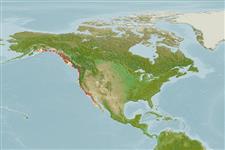Bivalvia |
Venerida |
Mactridae
Environment: milieu / climate zone / пределы глубины / distribution range
экология
; пределы глубины 0 - 50 m (ссылка 95344). Temperate; 61°N - 22°N, 156°W - 109°W
Eastern Pacific: from Alaska to Baja California, Mexico.
Length at first maturity / Size / Weight / Возраст
половая зрелость: Lm 6.8 range ? - ? cm Max length : 25.4 cm SHL самец/пол неопределен; (ссылка 95991); наибольший возраст (опубликованны данные): 17 годы (ссылка 95991)
It burrows in sand and mud along the intertidal zone from shallow depths to 30 meters (Ref. 865). Prefers sandier areas. Buries deep in the substrate to avoid freezing (Ref. 95344). Feeds on phytoplankton and detritus (Ref. 95991).
Life cycle and mating behavior
половая зрелость | размножение | нерест | Eggs | Fecundity | Larvae
Reproduction occurs throughout the year during spring, peak months on February and April.
Основная ссылка
ссылки | координатор | соавторы
Lamb, A., D. Gibbs and C. Gibbs 2011 Strait of Georgia biodiversity in relation to bull kelp abundance. Pacific Fisheries Resource Conservation Council, 111p. (ссылка 93817)
Статус Красного Списка МСОП
(ссылка 130435: Version 2025-1)
Статус СИТЕС (ссылка 108899)
Not Evaluated
CMS (ссылка 116361)
Not Evaluated
Угроза для людей
Использование человеком
рыболовство: коммерческий
FAO - аквакультура (рыбоводство): production; | FishSource | Sea Around Us
инструменты
дополнительная информация
PhysiologyOxygen consumption
Human RelatedStamps, coins, misc.
ресурсы в Интернет
Estimates based on models
Preferred temperature
(Ref.
115969): 8.6 - 15.3, mean 10.2 (based on 60 cells).
устойчивость к внешним воздействиям
низкий, минимальное время удвоения популяции 4.5-14 лет (K=0.12-0.17; tm=3; tmax=17).
Fishing Vulnerability
Moderate vulnerability (45 of 100).
Nutrients : Calcium = 149 [71, 228] mg/100g; Iron = 8.53 [1.95, 15.11] mg/100g; Protein = 9.88 [8.64, 11.12] %; Omega3 = 0.313 [0.202, 0.423] g/100g; Selenium = 61 [50, 72] μg/100g; VitaminA = 0 μg/100g; Zinc = 2.04 [0.56, 3.51] mg/100g (wet weight); based on
nutrient studies.
